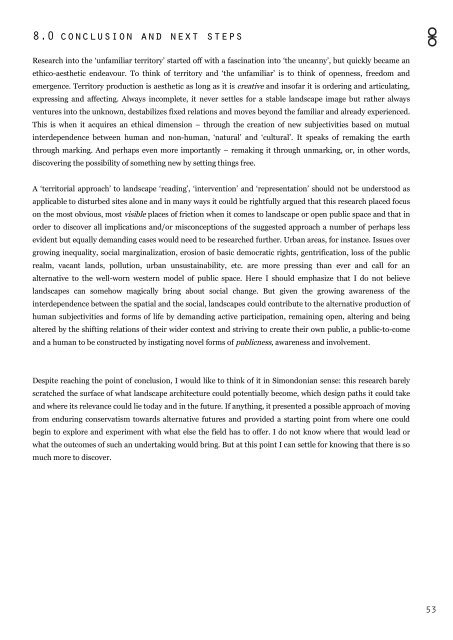Unfamiliar Territory_Research
You also want an ePaper? Increase the reach of your titles
YUMPU automatically turns print PDFs into web optimized ePapers that Google loves.
8.0 conclusion and next steps<br />
⚮<br />
<strong>Research</strong> into the ‘unfamiliar territory’ started off with a fascination into ‘the uncanny’, but quickly became an<br />
ethico-aesthetic endeavour. To think of territory and ‘the unfamiliar’ is to think of openness, freedom and<br />
emergence. <strong>Territory</strong> production is aesthetic as long as it is creative and insofar it is ordering and articulating,<br />
expressing and affecting. Always incomplete, it never settles for a stable landscape image but rather always<br />
ventures into the unknown, destabilizes fixed relations and moves beyond the familiar and already experienced.<br />
This is when it acquires an ethical dimension – through the creation of new subjectivities based on mutual<br />
interdependence between human and non-human, ‘natural’ and ‘cultural’. It speaks of remaking the earth<br />
through marking. And perhaps even more importantly – remaking it through unmarking, or, in other words,<br />
discovering the possibility of something new by setting things free.<br />
A ‘territorial approach’ to landscape ‘reading’, ‘intervention’ and ‘representation’ should not be understood as<br />
applicable to disturbed sites alone and in many ways it could be rightfully argued that this research placed focus<br />
on the most obvious, most visible places of friction when it comes to landscape or open public space and that in<br />
order to discover all implications and/or misconceptions of the suggested approach a number of perhaps less<br />
evident but equally demanding cases would need to be researched further. Urban areas, for instance. Issues over<br />
growing inequality, social marginalization, erosion of basic democratic rights, gentrification, loss of the public<br />
realm, vacant lands, pollution, urban unsustainability, etc. are more pressing than ever and call for an<br />
alternative to the well-worn western model of public space. Here I should emphasize that I do not believe<br />
landscapes can somehow magically bring about social change. But given the growing awareness of the<br />
interdependence between the spatial and the social, landscapes could contribute to the alternative production of<br />
human subjectivities and forms of life by demanding active participation, remaining open, altering and being<br />
altered by the shifting relations of their wider context and striving to create their own public, a public-to-come<br />
and a human to be constructed by instigating novel forms of publicness, awareness and involvement.<br />
Despite reaching the point of conclusion, I would like to think of it in Simondonian sense: this research barely<br />
scratched the surface of what landscape architecture could potentially become, which design paths it could take<br />
and where its relevance could lie today and in the future. If anything, it presented a possible approach of moving<br />
from enduring conservatism towards alternative futures and provided a starting point from where one could<br />
begin to explore and experiment with what else the field has to offer. I do not know where that would lead or<br />
what the outcomes of such an undertaking would bring. But at this point I can settle for knowing that there is so<br />
much more to discover.<br />
53


